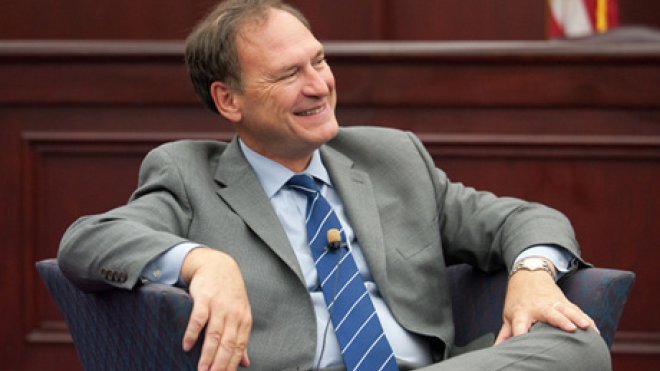Fireside Chat, RWU Law Style, With Supreme Court Justice Samuel Alito
U.S. Supreme Court Justice Samuel A. Alito spent Friday at the School of Law, meeting with students and faculty and teaching a Constitutional Law class

BRISTOL, R.I. – Samuel A. Alito, Jr., Associate Justice of the Supreme Court of the United States, spent the day at RWU Law Friday, meeting with students, teaching a Constitutional Law class and participating in a “fireside chat” with the Honorable Ronald A. Cass, a longtime friend of Alito and a member of the law school’s board of directors.
After enjoying a light breakfast with Mr. Cass, Dean David A. Logan, and a few standout law students, Justice Alito entered a packed classroom to teach a Con Law class. He observed that the Court’s October Term would begin in a couple of weeks, joking that he was, as ever, “filled with hope that this will finally be the term when all of my colleagues see the light of day” – a hope that “begins to fade five or ten minutes into the first case.”
Eschewing discussion of the Court’s controversial 5-4 decisions, Alito chose to focus on three cases in which the Court unanimously upheld individual liberties over government interventions. One case involved electronic police surveillance of a drug dealer, one an action against a property owner in violation of the Clean Water Act, and one a labor dispute between a teacher and a religious school.
In each case, Alito observed, the government was pursuing “laudable objectives; all things we want to see happen”– but in each instance the Court nonetheless ruled against the government, denying it powers “with alarming implications if we accepted them.”
A student asked about the role of public opinion upon the Supreme Court, and Alito replied that – due to the Justices’ life tenures – it mattered mainly during confirmation hearings. Listening to public opinion is “exactly what we’re not supposed to do,” Alito said.
Still, he noted, the Court’s public approval rating hovers at around 40 percent, which beats Congress’s dismal ratings by “a comfortable margin.” He added that a recent poll showed that more Americans can name two of Snow White’s seven dwarfs than can name two Supreme Court justices, and quipped, “I was just glad that people don’t think Grumpy, Dopey and Sleepy are Justices on the Court!”
Justice Alito then met with 25 student leaders, discussing a range of topics including the highly publicized incident when cameras showed the Justice quietly responding “Not true!” when President Obama critiqued the controversial Citizens United decision during his 2010 State of the Union address.
“This is my 15 minutes of fame,” Alito said of the incident, widely known among people who otherwise know little or nothing about him. He noted that even as a debater in high school, he would get marked down for making faces during his opponents’ arguments. He said he did not realize that the press received an advance transcript of the address and thus trained its cameras on the justices at the very moment the President mentioned the Court’s decision. If he had known, he would probably have kept a poker face.
Turning to less charged matters, Justice Alito answered a student’s query about the methods by which Supreme Court justices reach rulings “that at least five can agree on.” When the justices circulate a draft opinion among colleagues, he said, “what you want is a memo saying, ‘Perfect! Don’t change a word!’ What you get is, ‘if you take this or that [part of the opinion] out, I’ll sign.’”
Justice Alito noted that he had “absolutely no doubt” that the Court’s diversity would continue to grow, reflecting the changing fabric of the country, and opined against allowing cameras in the Court. “We’re a very old-fashioned institution,” he said, adding that cameras would fundamentally “change the structure of the arguments.”
On the one hand he referenced, disapprovingly, a television ad that attacked the Affordable Health Care Act by misleadingly using a voice recording of a government lawyer momentarily stammering during oral arguments at the Court. The ad characterized the audio clip as evidence that “even the President’s own lawyer can’t even defend the constitutionality of this law.” On the other hand, he joked, most of the Court’s less controversial cases would draw ratings even lower than C-SPAN broadcasts of Congressmen making speeches to an empty chamber.
Asked for career advice, the Justice noted that his own son had recently graduated from law school and said “attorneys have to be open to opportunities when they come up.” Regardless of one’s specific career goals, “it’s helpful to have a degree of flexibility as your career progresses.”
The Justice also talked about the different skill sets required for trial lawyers and appellate lawyers. For appellate lawyers, he said, “it’s important to have a feel for the particular tribunal before which you are to appeal,” to become familiar with the judges’ “zone of persuasion” and adjust one’s arguments to the “signals and vibes you get as to what’s working during argument,” just as a driver with a GPS might continually adjust his or her route to avoid traffic obstacles.
U.S. Supreme Court visits have become a tradition at Rhode Island’s only law school, a rare accomplishment for an institution not yet 20 years old (that anniversary is coming up next year). In 2011, students enjoyed a similar visit from Associate Justice Stephen Breyer. In 2008, Associate Justice Antonin Scalia spent a day with students at RWU Law, and earlier that same year Chief Justice John Roberts addressed its students and swore in more than 40 of its recent alumni to the federal bar. Groups of RWU Law students have also met with Associate Justice Ruth Bader Ginsburg, Associate Justice Elena Kagan, Associate Justice Anthony Kennedy and retired Associate Justice Sandra Day O’Connor.